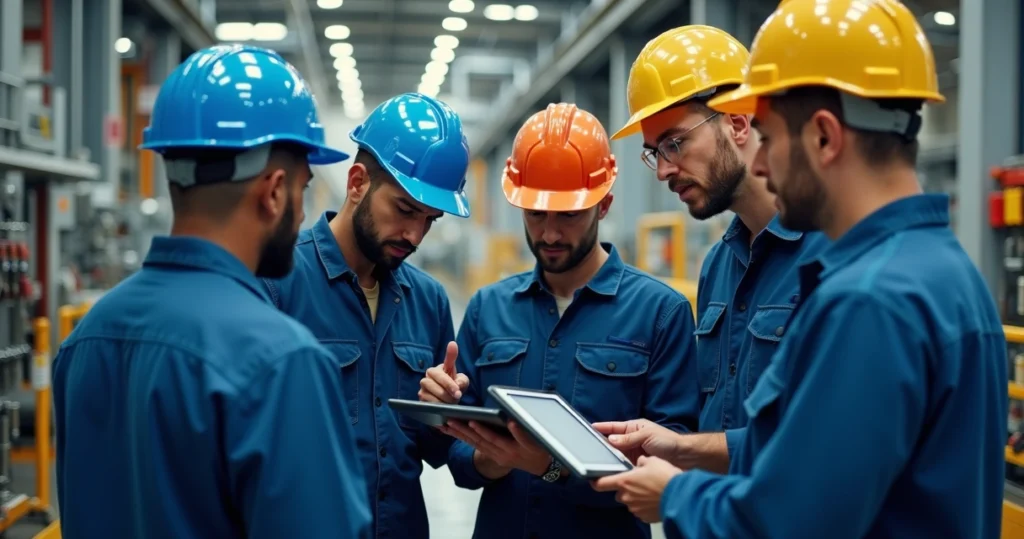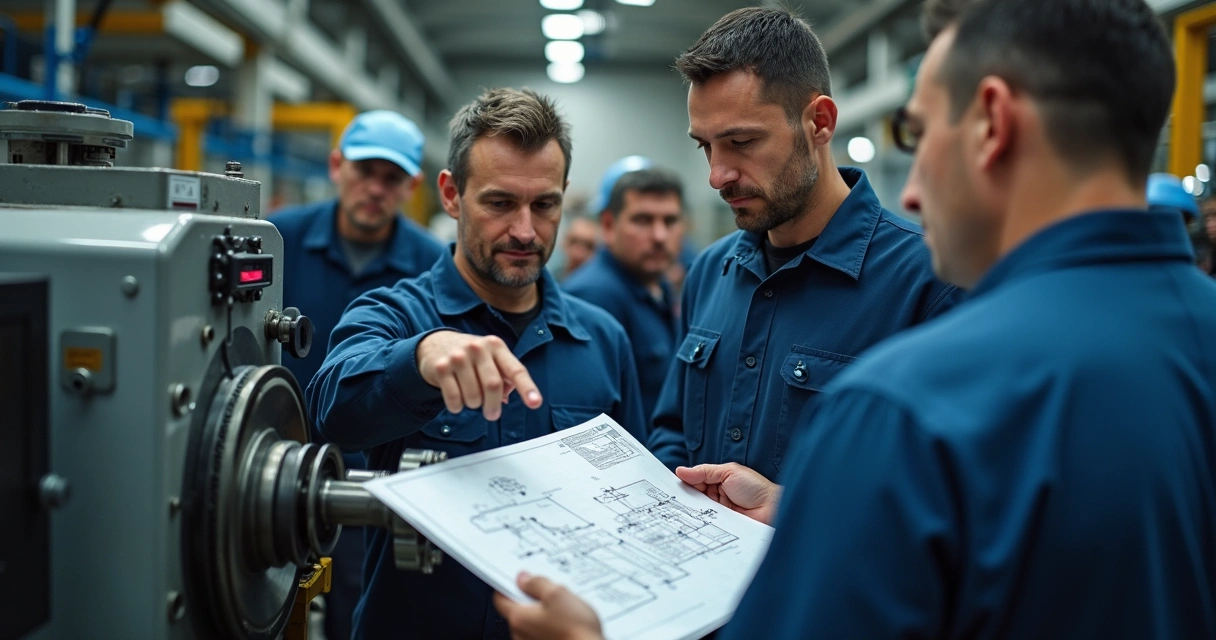7 Proven Methods to Improve Team Training in Maintenance

Maintenance teams make the invisible visible. Equipment hums quietly—until it doesn’t. Suddenly, the difference between downtime and smooth running depends on what your team knows, how they respond, and sometimes, how well they learn from yesterday.Building strong training programs is not simply about teaching technical skills. It’s about keeping your team sharp, engaged, and ready for what comes next. You might already know this. Still, putting the right steps in place can feel a bit overwhelming with all the buzz about modernization and digital tools. So, how do you find what works?This guide brings everything back to earth—actionable and backed by studies, experience, and clear results. Sometimes, it’s quieter wins, like fewer repeated mistakes. Other times, it’s measurable: faster response, fewer accidents, better reports.I’ve seen teams transform just with a few targeted changes. The best part? The methods don’t demand a massive overhaul. Just steady steps, and a bit of consistency.
Understanding the starting line: measuring training needs
Not all maintenance teams need the same skills or depth of knowledge. Some have seasoned troubleshooters. Others might be green and eager, but missing the ropes.The most practical way to build a useful training plan is to first assess what you have and identify the gaps. It might sound simple, but there’s a reason why evaluating team members’ capabilities to identify educational needs is the foundation for making training useful and not just “checking a box.”
- Interview team members. Ask what confuses them most, or what failures cause repeats.
- Observe work closely. Notice delays, errors, or unsafe shortcuts.
- Review equipment histories. Are the same faults happening? Are root cause analyses thorough?
- Scan compliance or audit reports. Recurring findings? Weak documentation?
Sometimes, the answers are obvious. Other times, you spot subtler clues in how reports are written or where process bottlenecks keep popping up. This early detective work shapes everything that follows. There’s no point in launching into advanced diagnostics if half the team still struggles with basic troubleshooting.
Method 1: on-the-job learning with real scenarios
Few things stick better than learning right where the problems happen. Classic classroom sessions have their place, but hands-on training with real situations cements skills in a way theory never will. Integrating practical, hands-on elements is often what separates teams that “sort of know” from those that really get it.
- Pair new workers with experienced mentors. Let learning happen while doing—questions flow naturally, and feedback is immediate.
- Simulate common or high-stakes breakdowns. Everyone can contribute without the pressure of an active failure.
- Rotate learning-specific tasks. Assign fault-finding, report creation, or procedure reviews as mini-projects.
This is where a diagnostic tool like Prelix makes a genuine difference. By supporting teams right at the source of the failure, Prelix helps them identify causes while the event is fresh, turning every problem into a teachable moment. Instead of vague guesses, teams work with real data, seeing why one root cause differs from another, and learning to spot patterns.
“Knowledge earned in action sticks the longest.”
Method 2: cross-training for resilience and flexibility
Every maintenance leader has felt the sting of losing a go-to team member—out sick, on vacation, or moving to a new role. Suddenly, tasks get shuffled, and pressure builds.Cross-training means preparing staff to work outside their primary job role—as defined in this explanation of cross-training. You don’t need everyone to know everything, but a broader skill set means fewer bottlenecks and faster responses.

- Identify tasks frequently delayed by staff shortages.
- Build paired or small group sessions where team members trade off roles.
- Encourage sharing of personal checklists and techniques—everyone has war stories or “go-to” fixes.
- Set simple tracking: who can do what, and what still needs coverage?
- Offer recognition for mastering new skills; a little acknowledgment goes a long way.
And yes, at first, some people might be reluctant (“That’s not my job!”), but over time, most discover that broader skills lead to smoother shifts. Studies emphasizing the value of cross-training link it not just to versatility, but also to greater team loyalty and even fewer repeated mistakes.
Method 3: microlearning for busy schedules
Let’s be honest, no one in maintenance is itching to sit for hours in a seminar, especially when urgent calls might come any minute.Microlearning answers this head-on. Quick, focused lessons—think five or ten minutes at a time—keep skills fresh without draining the whole day. This might look like short video clips, “one problem, one solution” guides, or even quick quizzes at the start of each shift.
- Send out weekly bite-sized tips.
- Pin short reference cards to common areas—lockout steps, reporting best practices, fault code lists.
- Let team members contribute their own quick wins; peer-taught tips often hit home best.
Short learning sprints prevent overwhelm and help the content stick. It’s repetition, not volume, that builds skill muscle. And—if your team uses digital documentation, like Prelix offers with instant reports and diagrams—embedding microlearning becomes even easier. Each new case becomes a mini-lesson for others.
“A little, learned often, lasts longer than a lot, learned once.”
Method 4: digital tools and learning management systems
Digital platforms have made learning accessible anywhere—a phone in the workshop, a tablet by the line. Learning Management Systems (LMS) take the messy bits out: scheduling, tracking progress, certifying results. As advocated by industry experts, using a digital backbone means no lost paperwork, faster rollout of new modules, and clear reporting.

- Assign required modules based on assessment results.
- Keep a running list of completed training, including dates and scores.
- Push out reminders when it’s time for refresher training or new process rollouts.
- Use the platform for feedback—short polls or quizzes make results measurable.
Platforms like Prelix help here too by making integration with current maintenance systems straightforward. Reports, digital diagrams, and five-whys analyses can feed right into ongoing learning, so lessons from problems don’t get lost but instead improve future performance.
Method 5: certification programs and clear career paths
Training isn’t just about skill—sometimes it’s motivation. Who wants to keep learning if it leads nowhere? Setting up certification programs and mapping out clear career steps turns training from a chore into a goal. As studies confirm, offering a visible path up boosts retention and drives performance.
- Create certificates for mastering particular machines, analysis methods, or reporting systems.
- Assign bonus titles or pay bumps for reaching new skill levels.
- Include regular check-ins about progress—annual or even semi-annual reviews to discuss what’s next.
- Ensure the path to “moving up” is clear, so training always feels purposeful.
Some teams like visible leaderboards, others prefer private feedback—find what fits your crew. The point is, when team members know that effort leads somewhere, their buy-in goes way up.
“Clear goals build steady motivation.”
Method 6: encouraging feedback and continuous improvement
Nothing stalls team learning faster than silence after training. Feedback is the engine of progress. It’s about more than just ticking boxes after a module; it’s exchanging real experiences—what worked, what tripped us up, what could be improved.You’ll find that ongoing feedback and continuous learning cycles turn training from a one-off project into an organic part of work life.
- After every training, ask: What was clear? What remains fuzzy?
- Request tweaks or suggestions for future content—your best ideas will come from the floor, not a conference room.
- Keep feedback low-pressure: anonymous surveys, suggestion boxes, or group debriefs.
Platforms like Prelix can support this too by collecting feedback right in the digital workflow, and by making it easy to spot recurring weak spots—if everyone stumbles on the same fault code, it’s time to address it head-on.
Method 7: tracking, measuring, and refining training programs
Improvement only comes when you know what’s working. It may seem slow—sometimes you question if the needle is even moving. Still, numbers reveal the story. Regular training can increase productivity by 30%, lower downtime, and cut safety incidents. But only if you track inputs and watch results.
![]()
- Keep track of post-training test scores or practical assessment performance.
- Measure incident rates before and after training cycles.
- Analyze feedback trends—are complaints about unclear procedures dropping?
- Monitor compliance and reporting speed.
- Log new certifications, cross-trained roles, and retention patterns.
If your needs get more advanced, explore resources like the RCA (Root Cause Analysis) practical guide. For teams moving toward digital transformation, the AI-powered RCA guide (in English) also helps address the unique measurement needs of blended digital training and hands-on learning.
Measurement does more than justify the time spent. When teams see real movement—better safety, faster troubleshooting, clearer reports—they start to believe in the system. Over time, that belief turns into a self-sustaining momentum.
Keeping everyone engaged: the “people” side of training
It’s tempting to focus on software or processes, but real improvement only happens when people want to participate. Maintenance work can get repetitive. For some, training is just another thing to check off. So how do you keep engagement up, day after day?
- Tell stories, not just steps. Share why procedures changed or what a near-miss taught you. Human stories stick.
- Let the quiet experts speak. Invite the veteran who solves impossible problems to lead a session. Passing down those tricks builds pride and camaraderie.
- Mistakes are gold. If someone stumbles (within reason), use it as a lesson for the group—not shame, just honest learning. Teams that talk openly about errors innovate faster.
- Mix things up. A little competition, friendly quizzes, or even rotating trainers shake off the training fatigue.
- Listen for warning signs. If training consistently gets low marks for relevance, or people look bored, adapt. Feedback loops matter here too.
Sometimes, just walking the floor and asking, “What would help you most next month?” delivers surprising ideas. Other times, it means showing appreciation for steady progress instead of chasing perfection.
The impact of continuous training on performance and safety
When training is consistent, tailored, and honestly assessed, the effects go beyond better wrench skills. According to industry research, the benefits include:
- More hours of uptime—fewer calls for the same glitch
- Better compliance and smoother audits
- Team members willing to step into new roles
- Safer workspaces—fewer near-misses and accidents
- Higher retention rates and visible morale boosts
- Noticeably improved reporting and documentation speed
Prelix users, for instance, find value in how instantly generated diagrams and five-whys analyses serve as on-the-job refreshers. Turn each incident into a low-stress learning session, not a failed mark.
“Consistent training grows safer teams.”
Conclusion: small changes, lasting difference
Effective maintenance training isn’t about perfection, or even about state-of-the-art tech. It’s steady, real-world practice. Teams need variety: on-the-job experience, digital microlearning, structured paths, and honest feedback. Over time, even small improvements ripple out—fewer breakdowns, safer shifts, and a growing sense of pride.If you’re looking for more step-by-step guides, have a look at the in-depth resources at the Prelix blog. Or, if you’re seeking detailed guidance in Portuguese, you’ll find articles at the Prelix Portuguese blog.Most of all, if you want your next training effort to stick, start with one method and build from there. Your team will see the progress—and you’ll see the results on the shop floor.Ready to transform your approach? Try Prelix for instant diagnosis, better reporting, and continuous learning in your maintenance operation.
Frequently asked questions
What is team training in maintenance?
Team training in maintenance means organized activities that help technicians and staff build the specific skills needed to keep equipment running, troubleshoot problems, and improve safety. It can include real-world practice, digital lessons, workshops, and peer coaching. The goal is to make sure the whole team works better together, is prepared for unexpected issues, and learns from each event—whether in a classroom or directly on the job.
How can I improve maintenance team training?
Focus on measuring current skills and needs first, then use hands-on learning, cross-training, microlearning, and digital tools to close the gaps. Encourage open feedback, set up clear paths for recognition or advancement, and use platforms (like Prelix) to blend real-time learning with structured tracking. Keep lessons brief and relevant. Mix in stories, team competitions, and practical simulations to keep everyone engaged.
What are the best methods for training?
The most effective methods blend several elements:
- On-the-job learning: Practicing skills during real tasks.
- Cross-training: Teaching staff to cover each other’s roles for flexibility.
- Microlearning: Very short, focused lessons that fit into busy days.
- Digital platforms: Online access to materials, tracking, and feedback.
- Certification and goal-setting: Motivating staff by recognizing progress.
- Continuous feedback: Regular review and adaptation of training content.
Combining these, as seen in industry guides and platforms like Prelix, offers real-world skill growth that lasts.
Is team training worth the investment?
Yes, strong evidence shows that targeted maintenance training can boost results by 30% or more, according to research on continuous training. You’ll likely see reduced downtime, higher morale, lower safety incidents, and better performance reviews. In short, a well-trained team is not only more capable, but also tends to stick around longer.
Where to find good training resources?
Start with digital guides and blogs that match your team’s needs. The RCA practical guide and the AI-powered root cause analysis guide are examples dedicated to industrial maintenance. Regularly updated content on the Prelix blog and Portuguese resources also offer hands-on tips tailored for maintenance teams. Mixing these with your in-house experience gives you the best, most relevant toolbox.
